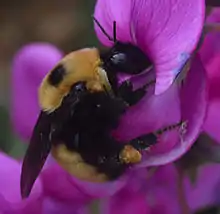Bombus nevadensis
Bombus nevadensis, the Nevada bumblebee, is a species of bumblebee. It is native to North America, where it occurs from Alaska to California in the west, and east to Wisconsin, and in Arizona, New Mexico, and Mexico.[1]
| Bombus nevadensis | |
|---|---|
 | |
| Scientific classification | |
| Kingdom: | Animalia |
| Phylum: | Arthropoda |
| Class: | Insecta |
| Order: | Hymenoptera |
| Family: | Apidae |
| Genus: | Bombus |
| Subgenus: | Bombias |
| Species: | B. nevadensis |
| Binomial name | |
| Bombus nevadensis (Cresson, 1874) | |
Description
A bumblebee with a long proboscis (tongue) and a short, dense fur, the females (queens and workers) have an entirely black head, while the face and top of the head of the male are yellow.[2] The thorax is yellow, sometimes with a hairless, black spot in the middle. The three first terga (abdominal segments) are yellow, while the rest of the abdomen is black.[1] However, the tip of the tail is more or less red in the male.[1] The average body length is 20 mm (0.79 in) for the queen, 17 mm (0.67 in) (worker) and 14 mm (0.55 in) (male).[2]
The black and gold bumblebee (Bombus auricomus) is sometimes considered a subspecies of this species, B. nevadensis auricomus.[1] Genetic and morphological evidence supports them as separate species.[3]
Ecology
This species inhabits open areas such as prairies and meadows. It usually nests underground. Food plants include milkvetches, thistles, melilots, bergamot, penstemons, phacelias, salvias, betony, and clovers.[3]
References
- "North American bumblebees". Bumblebee.org. Retrieved 26 January 2013.
- Anthony P. Solli (1999-10-20). "Bees: An Interdisciplinary Approach". Yale-New Haven Teachers Institute. Archived from the original on 9 September 2009. Retrieved 26 January 2013.
- Hatfield, R., et al. 2015. Bombus nevadensis. The IUCN Red List of Threatened Species. Downloaded on 04 March 2016.
